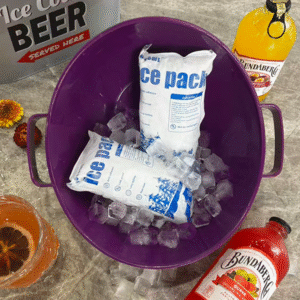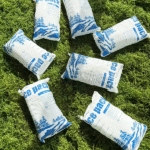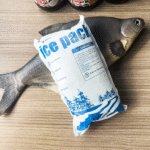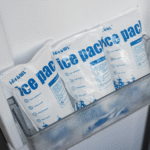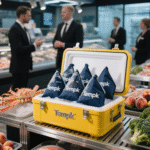Ao transportar produtos congelados entre cidades ou continentes, a estabilidade da temperatura não é opcional – é a reputação da sua marca que está em jogo. Frozen goods dry ice pack sheets have become a trusted tool for logistics managers and distributors who need precise temperature control without excessive cost or weight. These versatile cooling sheets maintain sub-zero conditions, Evite deterioração, and ensure compliance with modern cold chain standards.
Neste guia, you’ll learn how dry ice pack sheets outperform traditional coolants, how to select the right ones for your products, e o que 2025 industry trends are reshaping cold logistics efficiency.
-
How dry ice pack sheets improve cold chain efficiency and compliance
-
The differences between dry ice sheets and traditional cooling methods
-
Key use cases across food, farmacêutico, e logística de biotecnologia
-
Emergente 2025 cold chain trends and sustainability innovations
-
Practical steps for selecting and deploying dry ice pack sheets effectively
Why Are Frozen Goods Dry Ice Pack Sheets Essential for Modern Cold Logistics?
Dry ice pack sheets deliver reliable, long-duration cooling performance with minimal weight and zero leakage risk. They are pre-filled polymer sheets that can be activated with CO₂ or stored frozen, providing temperatures as low as -78.5°C — perfect for frozen foods, vacinas, e biológicos.
Unlike gel packs or water-based ice packs, dry ice sheets sublimate directly into gas, maintaining consistent cold without moisture damage. This makes them ideal for high-value or humidity-sensitive cargo.
From a business standpoint, using dry ice pack sheets reduces shipping losses, extends delivery zones, and strengthens compliance with global cold chain standards such as GDP (Boas Práticas de Distribuição).
Como funcionam as folhas de gelo seco?
Dry ice pack sheets combine CO₂ sublimation cooling with advanced insulation materials that control gas release and temperature duration.
Each sheet contains compact dry ice cells enclosed in multi-layer polymer film, preventing direct contact while maximizing cold air distribution. As CO₂ sublimates, absorve grandes quantidades de calor, keeping the environment cold for 24–96 hours depending on thickness and insulation.
| Cooling Component | Função | Duração típica | For Your Business |
|---|---|---|---|
| CO₂ Sublimation | Absorbs latent heat efficiently | 48–96 horas | Long-lasting temperature control |
| Polymer Film Layer | Prevents moisture exposure | Contínuo | Protects packaging and product labels |
| Thermal Cell Design | Even cold distribution | 24–72 horas | Ensures uniform freezing and minimal waste |
Real-World Benefits for B2B Cold Chain Operators
-
Perda reduzida de produto: Maintains temperatures below -18°C for extended transit durations.
-
Lower operational costs: Eliminates need for mechanical refrigeration in short hauls.
-
Simplified handling: Leve, leak-proof sheets are easier to load and stack.
-
Pronto de conformidade: Supports pharmaceutical GDP and FDA food transport guidelines.
Exemplo de caso:
A seafood exporter in Alaska reduced spoilage rates by 37% after switching to dry ice pack sheets. The new system maintained sub-zero conditions for 72 hours without requiring bulky insulated boxes.
How Do Dry Ice Pack Sheets Compare to Traditional Cooling Systems?
Dry ice pack sheets offer a superior ratio of cooling power to weight compared to gel packs or ice bricks. While gel packs provide 0°C cooling for fresh goods, dry ice maintains much lower temperatures — essential for frozen and deep-frozen items.
| Método de resfriamento | Faixa de temperatura | Risco de umidade | Duração | Typical Application |
|---|---|---|---|---|
| Folha de gelo seco | -78.5°C a -18 °C | Nenhum | 48–96 horas | Alimentos congelados, vacinas |
| Pacote de gel | 0°C a +5°C | Médio | 12–36 hrs | Produção fresca, laticínio |
| Pacote de gelo de água | 0°C | Alto | <12 hrs | Short-term local delivery |
| Refrigerated Container | Ajustável | Baixo | Contínuo | Bulk ocean freight |
Resumidamente: dry ice sheets are unmatched for flexibility, confiabilidade, and moisture-free cold maintenance, especially for long-haul or high-value goods.
Why B2B Logistics Managers Prefer Dry Ice Sheets
-
Temperature integrity: Crucial for FDA and WHO compliance.
-
Eficiência espacial: Sheets are thin, dobrável, e reutilizável.
-
Menor pegada de carbono: Require no electricity during transit.
-
Multi-industry adaptability: Suitable for pharmaceuticals, frutos do mar, and frozen meal kits.
Insight da indústria:
De acordo com o 2025 Cold Chain Market Outlook, sobre 62% dos distribuidores farmacêuticos globais have shifted to hybrid packaging using dry ice pack sheets to replace traditional ice or coolant gels.
Applications of Frozen Goods Dry Ice Pack Sheets Across Industries
Distribuição de alimentos: Ensuring Frozen Integrity from Plant to Plate
Food distributors rely on dry ice pack sheets to maintain consistent temperatures across every distribution stage. Whether shipping frozen meats, itens de padaria, ou frutos do mar, dry ice sheets prevent thawing, moisture condensation, e crescimento microbiano.
Caso de uso:
A European frozen dessert manufacturer uses dry ice sheets for weekly exports. Despite 48-hour airfreight, temperature deviation stays within ±1°C — preserving texture and flavor integrity.
Benefits for food distributors:
-
No meltwater or contamination risk
-
Easier storage in compact rolls
-
Better cost efficiency for long-haul deliveries
Pharmaceutical and Biotech Logistics
For pharmaceutical distributors and biotech firms, temperature excursions are costly — and dangerous. Frozen goods dry ice pack sheets ensure that vaccines, enzimas, and tissue samples remain at the correct temperature range even in fluctuating environments.
Vantagens:
-
Maintains strict cold thresholds (down to -70°C)
-
Meets WHO and EU GDP standards
-
Reduces dependency on powered cooling during transit
Exemplo:
A pharmaceutical logistics company in Singapore replaced dry ice pellets with structured dry ice sheets, alcançar um 20% reduction in CO₂ usage and eliminating manual refill needs.
E-Commerce and Frozen Meal Delivery
The rise of direct-to-consumer frozen food brands has increased demand for leve, non-leaking cold packs. While this segment remains primarily B2C, distributors handling last-mile operations benefit from the same reliability and efficiency.
Folhas de gelo seco enable smaller shipments to maintain quality over unpredictable delivery windows.
| Setor | Primary Benefit | Typical Shipment Duration | Key Concern |
|---|---|---|---|
| Distribuição de alimentos | Uniform freezing | 48–96 horas | Product quality retention |
| Farmacêutico | Conformidade regulatória | 24–72 horas | Temperature validation |
| Logistics Providers | Cost-efficient operation | 72+ hrs | Reduced fuel/energy use |
Choosing the Right Dry Ice Pack Sheet for Your Business
Key Factors to Evaluate
-
Sensibilidade do Produto: Determine whether your items require deep freeze (-70°C) or moderate freezing (-20°C).
-
Duração do trânsito: Longer transits need thicker or higher-density sheets.
-
Packaging Volume: Match sheet dimensions to minimize unused space.
-
Impacto Ambiental: Opt for recyclable or reusable polymer layers.
Para a ponta: Always test pack configurations under simulated conditions before full-scale deployment.
Dry Ice Sheet Thickness vs. Desempenho
| Grossura (milímetros) | Duração do resfriamento | Recommended Use Case | Business Benefit |
|---|---|---|---|
| 5milímetros | 24–36 hrs | Entrega local de congelados | Leve, flexível |
| 10milímetros | 48–72 horas | Medium-haul shipments | Peso/resfriamento balanceado |
| 20mm+ | 96 hrs+ | Internacional ou farmacêutica | Retenção prolongada de frio |
Dica prática: A combinação de chapas de diferentes espessuras cria um multi-zone cooling effect, stabilizing temperature gradients in mixed-load cargo.
2025 Trends in Frozen Goods Cold Chain Technology
1. Sustainability and CO₂ Efficiency
Em 2025, dry ice recycling systems have become standard in major logistics hubs. By reusing sublimated CO₂ gas, companies reduce emissions and operational costs.
2. Monitoramento de temperatura inteligente
IoT-based data loggers now integrate directly into dry ice sheet shipments, oferta real-time cold chain visibility through cloud dashboards.
3. Soluções de embalagens híbridas
Combinando materiais de mudança de fase (PCMs) with dry ice sheets ensures stable temperature transitions during customs delays or multi-zone shipping.
Perspectivas da indústria (2025–2030):
-
7.5% CAGR in frozen logistics segment
-
15% reduction in CO₂ waste via reusable dry ice packs
-
Increasing adoption in biotech and food export sectors
Perguntas frequentes
Q1: How long can frozen goods dry ice pack sheets last during transport?
Typically 48–96 hours, depending on sheet thickness, isolamento, e temperatura ambiente.
Q2: Are dry ice sheets safe for air freight?
Sim. When properly packaged and labeled, they comply with IATA regulations for dry ice shipments.
Q3: As folhas de gelo seco podem ser reutilizadas?
Many modern versions are designed for multiple cycles, especially those with reinforced polymer coatings.
Q4: What’s the best storage method for unused sheets?
Keep in sealed containers or freezers below -20°C to prevent premature sublimation.
Q5: How do dry ice sheets support sustainability goals?
They minimize CO₂ waste, reduce fuel dependency, and eliminate liquid waste from melted ice.
Conclusion and Strategic Takeaways
Frozen goods dry ice pack sheets are transforming cold logistics by combining high-performance cooling with operational simplicity. They keep frozen products intact, compatível, and profitable — even under challenging transit conditions.
Takeaways -chave:
-
Dry ice sheets offer superior sub-zero stability without leaks or power use.
-
They reduce operational costs and regulatory risk for B2B logistics.
-
Sustainability innovations in 2025 make them even more cost-efficient.
PRÓXIMOS PASSOS:
-
Evaluate your current cold chain performance metrics.
-
Test different sheet densities across routes.
-
Partner with reliable cold chain packaging suppliers for bulk customization.
Sobre Tempk
No Tempk, we specialize in advanced cold chain packaging solutions for global industries — from pharmaceuticals to frozen foods. Nosso folhas de embalagens de gelo seco combine high thermal efficiency, segurança, e sustentabilidade, designed to meet the latest 2025 logistics standards.
Trabalhamos junto com distribuidores e fornecedores de logística para otimizar sistemas de transporte de frio através de isolamento personalizado, embalagem reutilizável, e métodos de resfriamento eficientes em CO₂.
Pronto para otimizar suas remessas congeladas?
Entre em contato com Tempk hoje para uma consulta gratuita sobre integração de placas de gelo seco e otimização da cadeia de frio.






